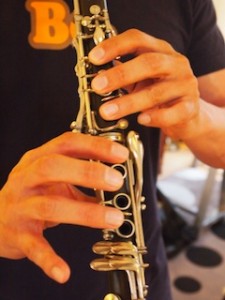Learning how to Improvise
Learning how to improvise can be one of the most rewarding aspects of clarinet playing. What a sense of joy and freedom it can bring to create melodies with spontaneity and ease. Many students stop before reaching this point, intimidated by the seemingly daunting task of “performing without a net”. This need not be the case. Improvising is as natural and central to our human nature as speaking. Remember that speaking had to be learned as a child, and likewise, everyone has the capacity to learn musical improvisation.
Various approaches to improvisation
There are various different approaches to improvisation. We will start with an area of focus based on your interest, and use that as a springboard to gradually expand into other approaches.
Some approaches covered are:
• ad libbing – embelishing the melody, but never leaving it completely.
• modal improvisation – improvising in the context of a particular scale or mode.
• chordal improvising or “playing changes” – improvising melodically through pre-set chord sequences.
• free form improvisation- creating spontaneous melodies without conforming to preset chords or scales.
Beginning improvisers
Beginning improvisers learn 7th chords, and basic harmonic structures commonly used in jazz improvisation. We will cover nuance devices such as glissando, breath tones, pitch bending, and sub-tone. You will learn several blues melodies and begin improvising at the very first lesson!
Advanced improvisers
Advanced improvisation lessons cover all aspects of chordal harmony. 7th, 9th, 11th, 13th chords are covered, as well as alterations and their applied usage (b5ths, b9ths, #11ths, etc..).
• leading tone harmony (choosing the next melodic note)
• harmonic rhythm (how the improvised melody corresponds to the chord changes).
• thematic improvisation (basing an improvisation on a theme or theme fragment),
• melodic improvisation (creating melodic “sentences” by playing through chord changes.
• ii-V-I sequences, with focus on various ways to resolve phrases through chord patterns.
• phrasing
• song form/stucture
• time/rhythm
Solo Transcription/Memorization
Improvisation students will also have the opportunity to learn directly from the great jazz masters by transcribing (writing
out) and learning to play one or more of their recorded improvisations. This will be a recording that the student already knows “by heart”, listens to all the time, and loves. Not only are the notes and rhythms learned this way, but also all the subtle inflections including breath tones, pitch bends, silent tones, and note “fall offs”.
Its All About Self Expression
